I have started a new project; pants based on the Jedediah Pants pattern from Thread Theory Designs.
This “new” project is actually a continuation of the “Breakfast Club Wardrobe” project, though since it had gone on for so long I’m splitting it into two projects: the shirts (completed) and now the pants.
Given the amount of effort involved in producing a hand-made garment, I’ve come to realize that the effort is wasted if the fit and style aren’t also right. So I’m really trying to get the fit right before making three pairs of pants based on the pattern.
For readers new to the blog, this is not the first time I’ve wrestled with fitting this pattern. I’ve made several past attempts to fit these pants:
This latest round of fitting picks up where I left off.
Muslins
One thing I learned from the previous rounds of muslins is that the choice of fabric does make a big difference in fit, as the pants drape and hang quite differently. The early muslins were in polyester, which fit quite differently from the shorts I made in cotton twill.
For a little better fidelity in fitting, I decided to experiment with actual muslin fabric. Fabric Outlet had a recent sale on muslin, so I purchased some in a weight as close to the twill as I could get. I’ve been cutting patterns out of muslin and joining them together by machine with a basting stitch – a regular straight stitch with a 5.0 stitch length. Oddly, the Juki doesn’t have a dedicated basting stitch in its repertoire of 625 stitches.
Inseam Ease
The Jedediah Pants pattern has a good amount of ease in the inseam between the crotch point, and the first notch around the knee. On my pattern, the front piece is somewhere around 3/4 inch longer than the back between those two points, which is really noticeable. I pinned the front and back pieces together at the crotch point and the midseam notch in this photo, to show off the extra ease.
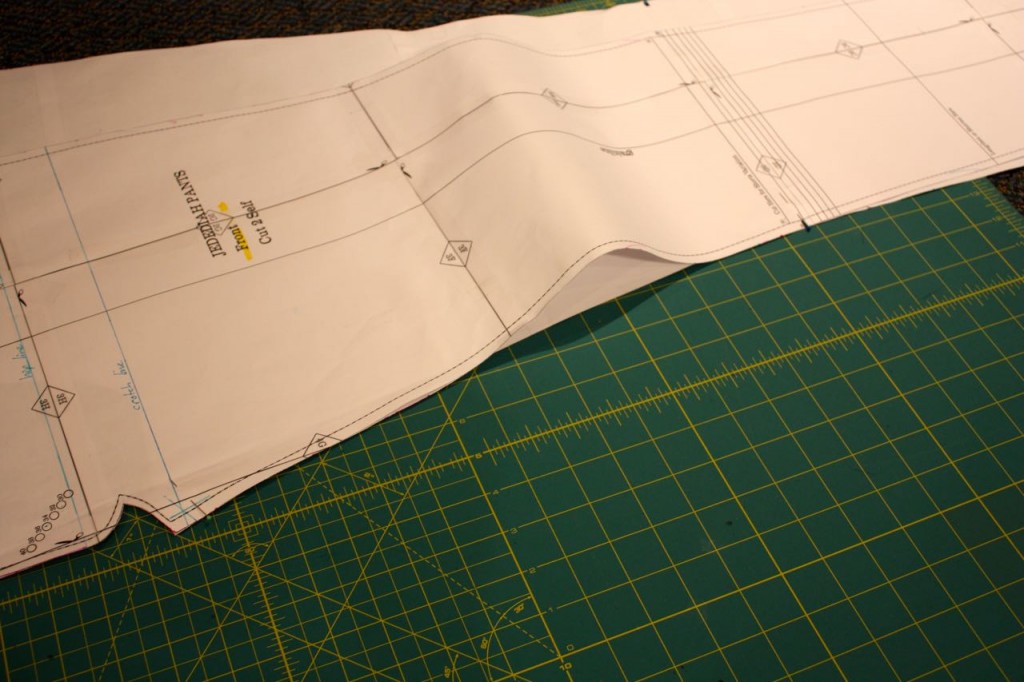
When I made the grey shorts, I eased the front and back pieces together on the machine. But did I make a mistake with my pattern alterations, or is it supposed to be this way?
I wrote Thread Theory via their website, and got the following response from proprietor Morgan Meredith:
In regards to the length of the inseams on the Jedediah Pants, yes they were intentionally drafted this way. We’ve included a diagram and explanation for this on page 6 of the instruction booklet. The pant legs are designed to be stretched in certain areas using steam from the iron to create ease at the knees (to prevent bagging in the future) and at the thigh centre front. This stretching will end up creating inseams that are easier ease when stitching the seam.
So, that answers that question!
Wrinkles in the seat
The shorts I had made in the gray twill had some really unsightly wrinkles just underneath the seat.

Figuring out how to eliminate these wrinkles was enough to make me set the problem aside.
Since then, I’ve been watching a new program on public television called “Fit 2 Stitch”. The host, Peggy Sagers, focuses on garment construction, and especially on fitting. She demonstrates techniques for creating flat patterns, but she also shows how to use draping to correct fit issues and transfer the corrections back to the pattern.
There’s been a few episodes featuring pants fitting, and one of them is online. Though the entire show is worth watching, she does something interesting about 14 minutes into the show; she demonstrates how to create a dart to remove the excess fabric that pools underneath the seat.
Now, you don’t want a dart going across the back of your ass. But here’s the magic insight I got from Peggy Sagers: if you can make the dart start and end on a seamline, you don’t need to keep the dart in the pattern; you can simply subtract the fabric from the pattern. The easiest way is to simply fold the dart out of the pattern. The pattern still lays flat after the change, and you can move on with your life.
First Attempt
For the first attempt at removing this excess fabric, I pinned out a dart with the point at the inseam, and the wide part on the side seam. (I also attempted to pin out some fabric that was pooling right between the yoke and pockets). Pinning the excess fabric while looking at myself in the mirror was pretty challenging.
Next, I used a tip from Kenneth King’s “Smart Fitting” series of articles in Threads Magazine (issues 147 through 150). I drew across the edge of the pinned area with a pen to mark the region to remove.

Sadly, the region I pinned out (in red below) turned out to be a curved dart. This situation didn’t happen on Peggy Sagers’ TV show. I considered the situation for a while, then drew a straight dart (in blue) to try to approximate it as much as possible.
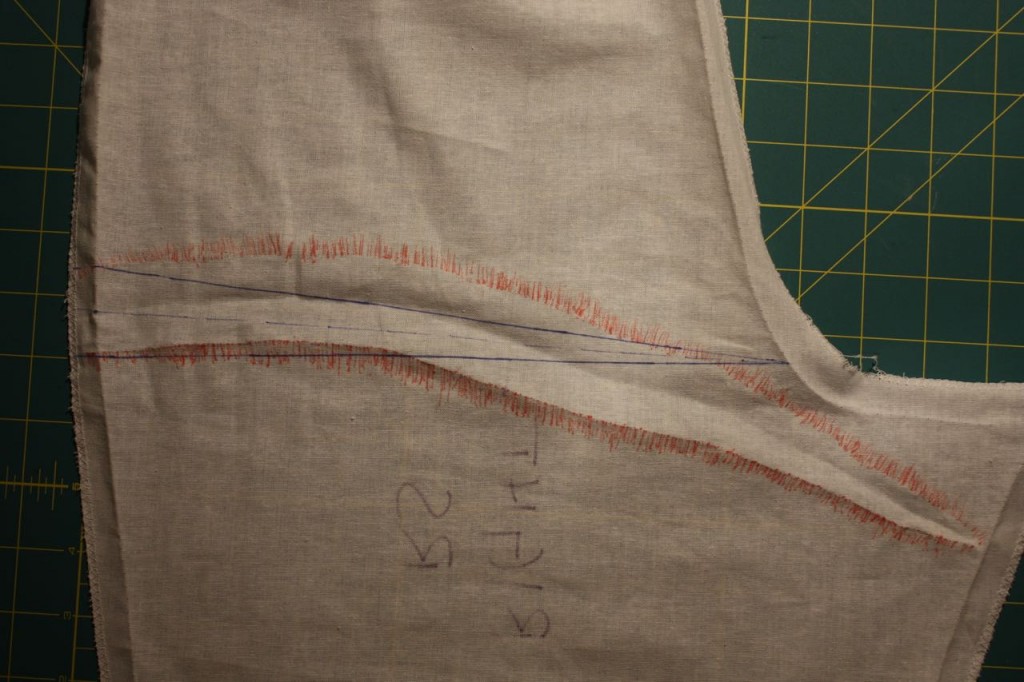
I stitched in the darts, and reassembled the muslin.
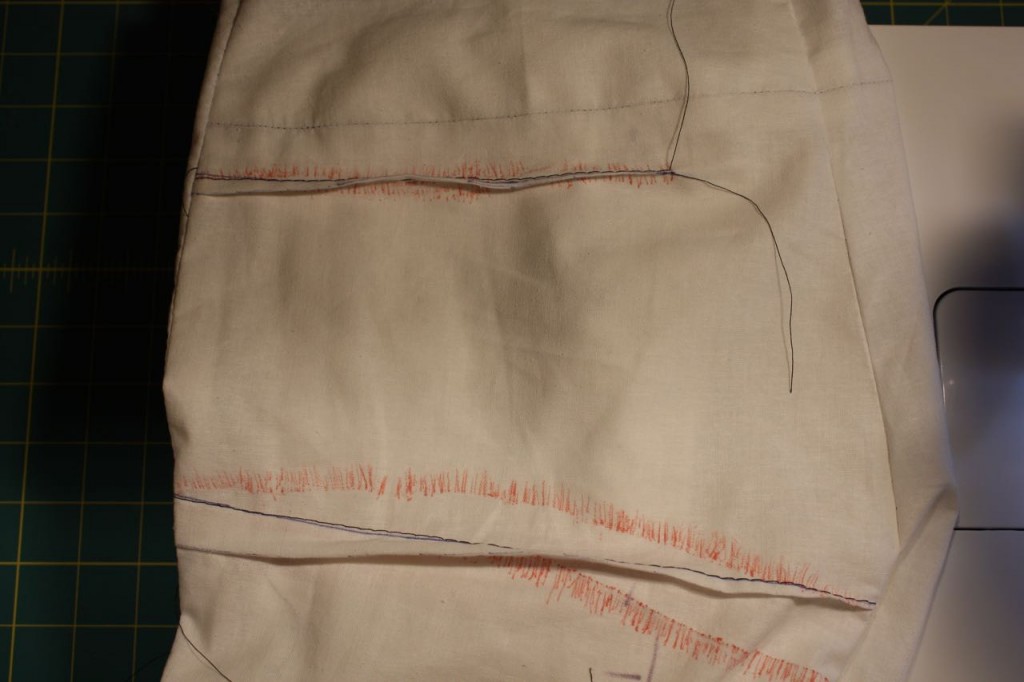
The alteration was partially successful. Here, I’m modeling the original pattern on the left leg, and the darted version on the right. The right side looks a little better, but not by a whole lot.

Second Attempt
After watching the episode above another time, and watching the other episodes (from season 1) where Peggy Sagers adjusts pants, I noticed that she always put the point of her darts on the side seam and the wide part towards the inseam, the reverse of the way I had done it.
So I tried doing that on the left leg. What I got was a straight dart (the lower one in the photo below), that had its apex on the side seam but took a good section (nearly 3 inches) out of the crotch curve on the center back seam. (The upper dart was yet another attempt to remove excess fabric between the yoke and pocket.)
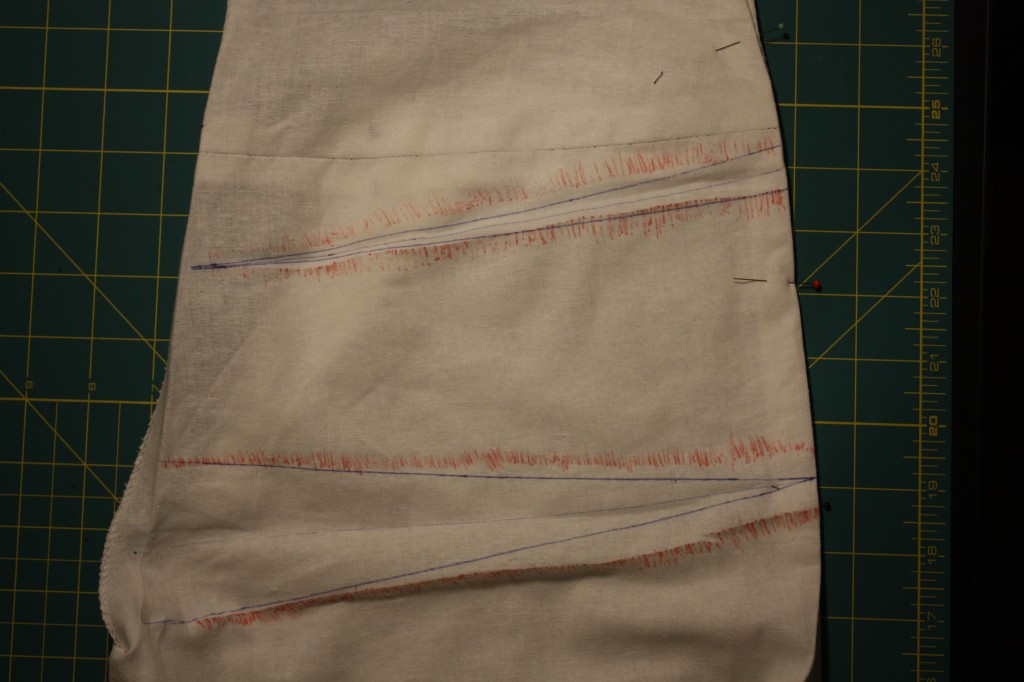
This was a mixed bag. The wrinkles were alleviated.
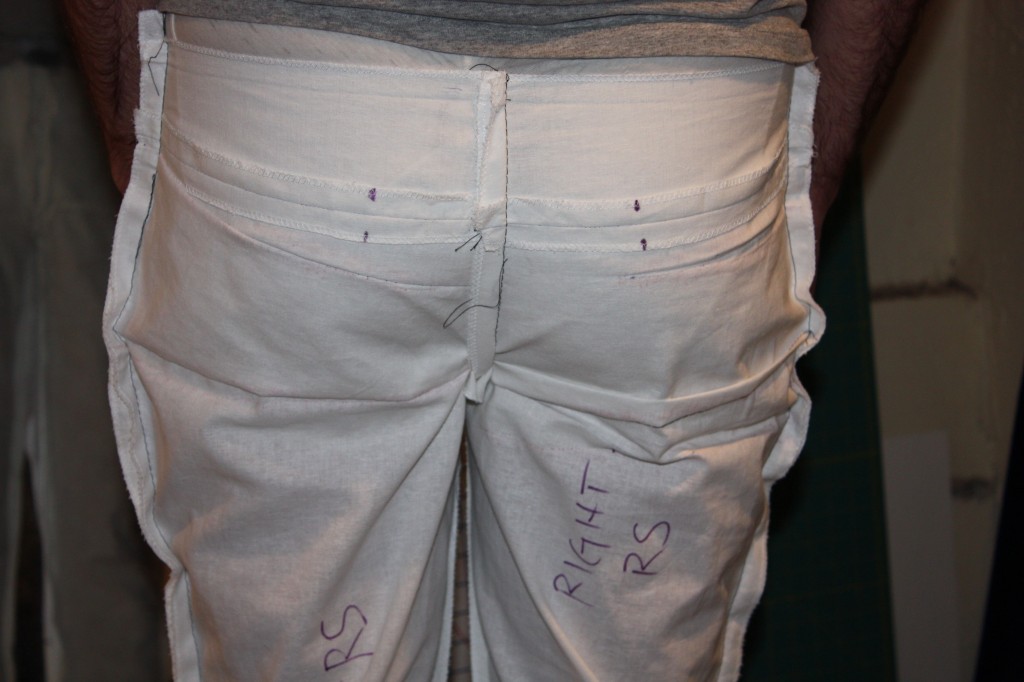 But a new problem appeared, worse than the wrinkles. A crazy diagonal twist now radiated from the center crotch out to the knee area.
But a new problem appeared, worse than the wrinkles. A crazy diagonal twist now radiated from the center crotch out to the knee area.
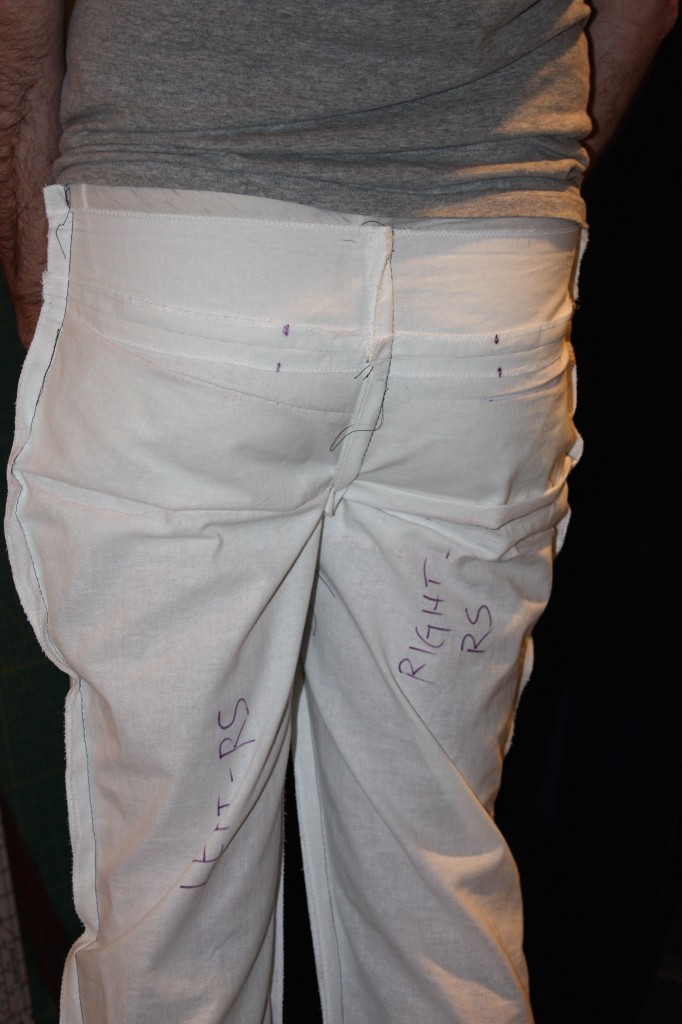
I figured that the pant legs were now off grain as a result of the alteration. To illustrate what I mean, first look at how I removed the dart from the seat area, by folding it out of the paper pattern. Already you can see the grain line at top ends up on an angle.
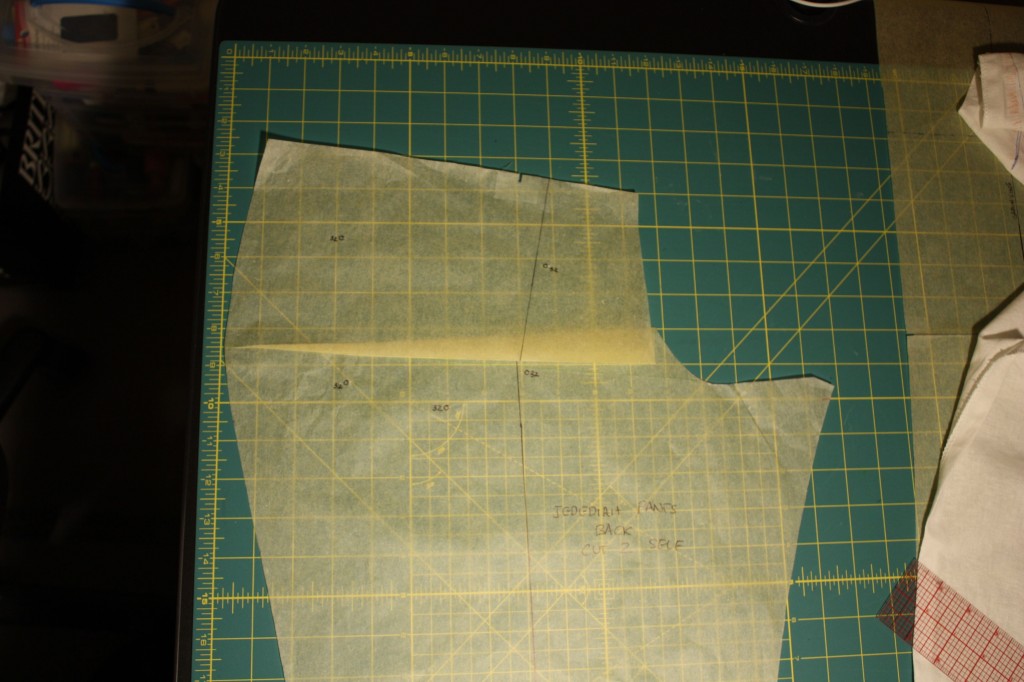
Now, when you overlay that on the traced pattern piece after the foldout, it becomes obvious that if the waistline falls more less on grain, the legs end up seriously off grain after sewing out the dart in my muslin.
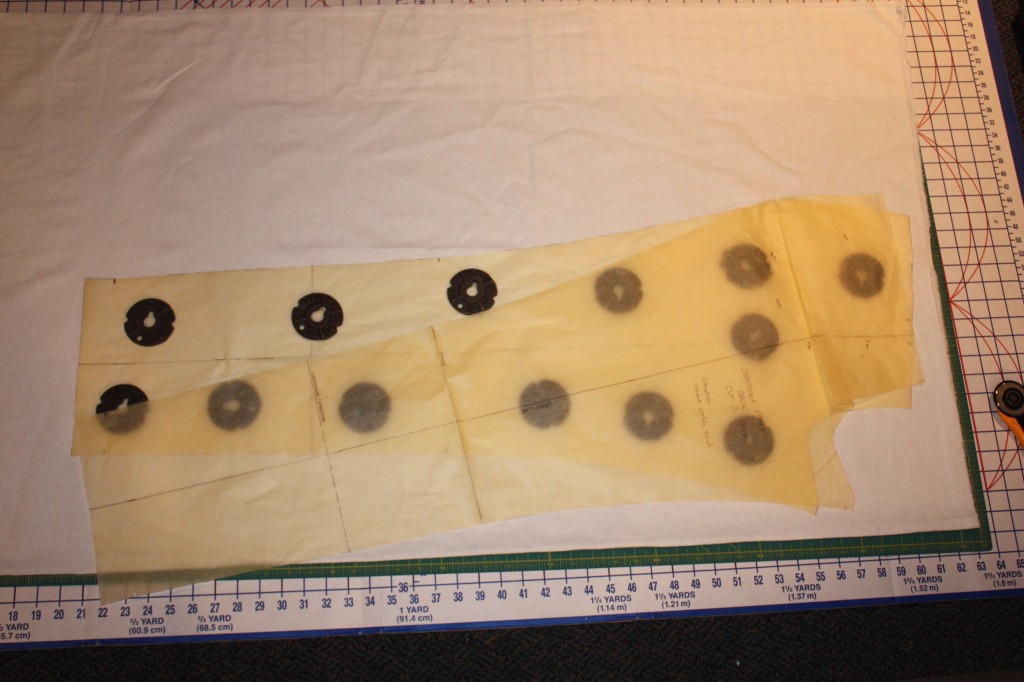
So I went ahead and cut a new muslin piece for the back pattern minus dart, with the grain line for the legs matching the fabric. I hoped this would solve the problem.
Here’s the pants resewn, with a newly cut muslin after the dart has been completely removed from the pattern. The good news is, the wrinkles under the seat are much improved.
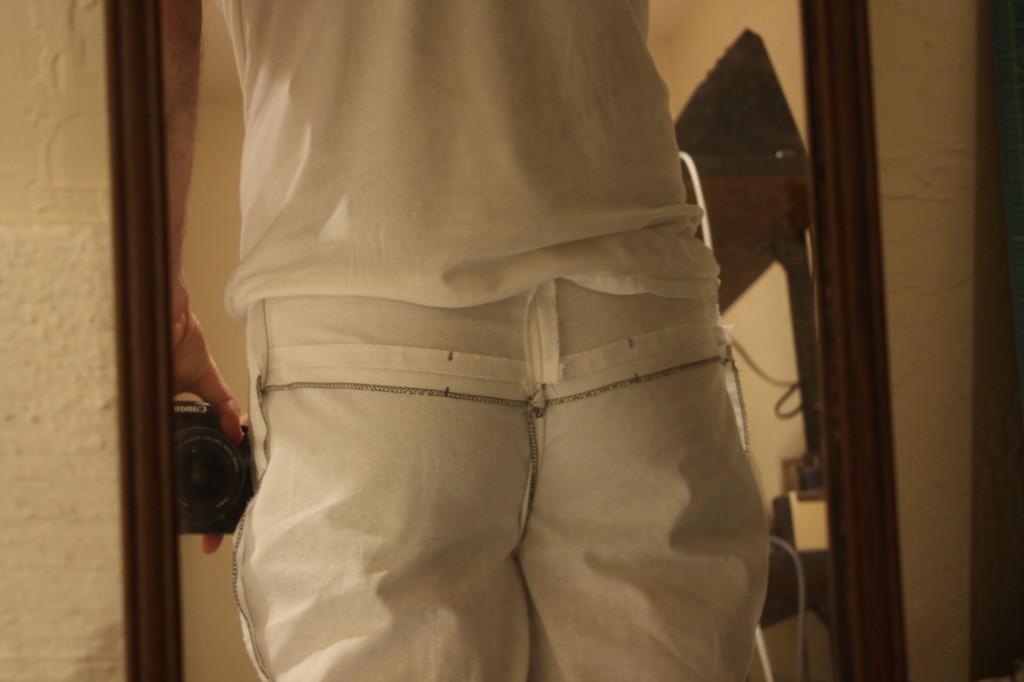
The bad news is, the crazy twist lines from crotch point to knees still remain.
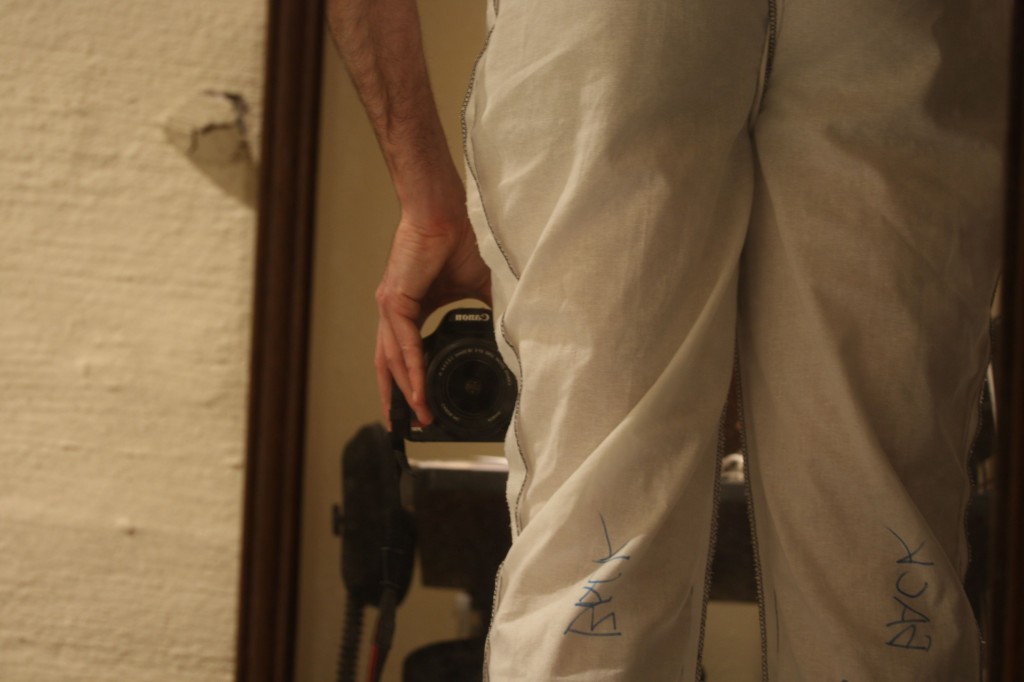
And I noticed a new problem, just as bad as the crazy twist lines. Removing the dart shortens the crotch curve considerably, by about 3 inches. The waist of the pants in back now fall substantially lower than they should. In the photo below, the underwear waistband indicates where my preferred waistline falls. In front, the pants line up right against the bottom of the underwear waistband. (The pants muslin has no waistband of its own).
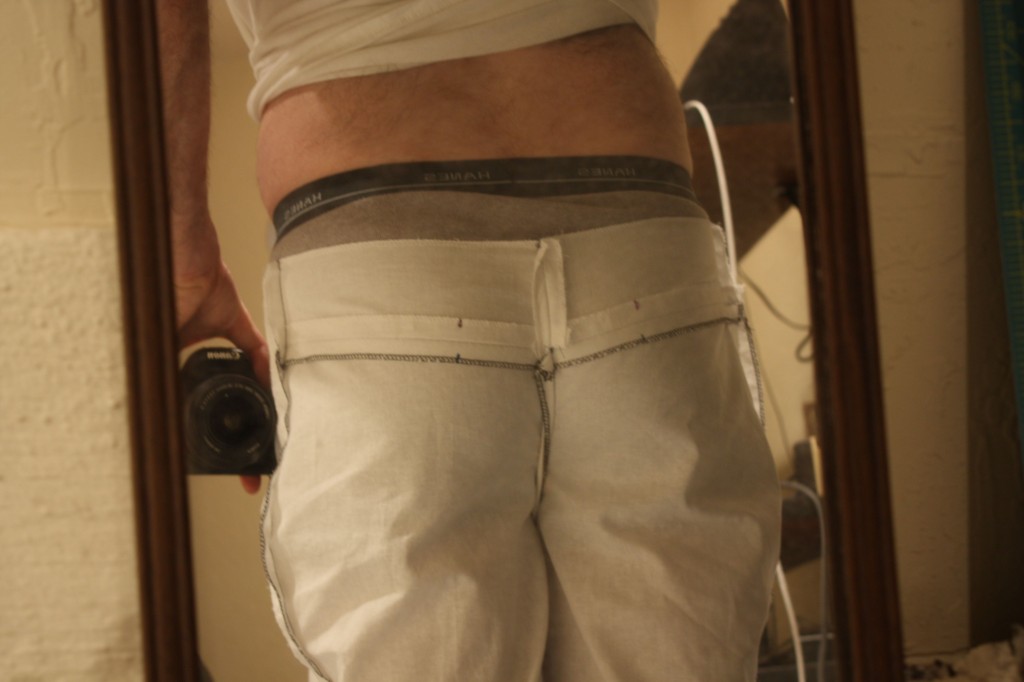
Third Attempt
In Kenneth King’s “Smart Fitting” series, he describes a pattern alteration he calls “no net change” – meaning fabric is removed from the pattern where it isn’t wanted, but added back somewhere else in order to keep the pattern pieces in alignment.
Using the “no net change” concept to fix the waistline, we can add the dart back in at the top of the pants back, right at the seam between pant back and yoke piece.
This is easily done by pivoting the original pattern piece up to add back in the missing wedge of fabric. I chose to pivot the original pattern to the point where the grainlines fall into alignment.
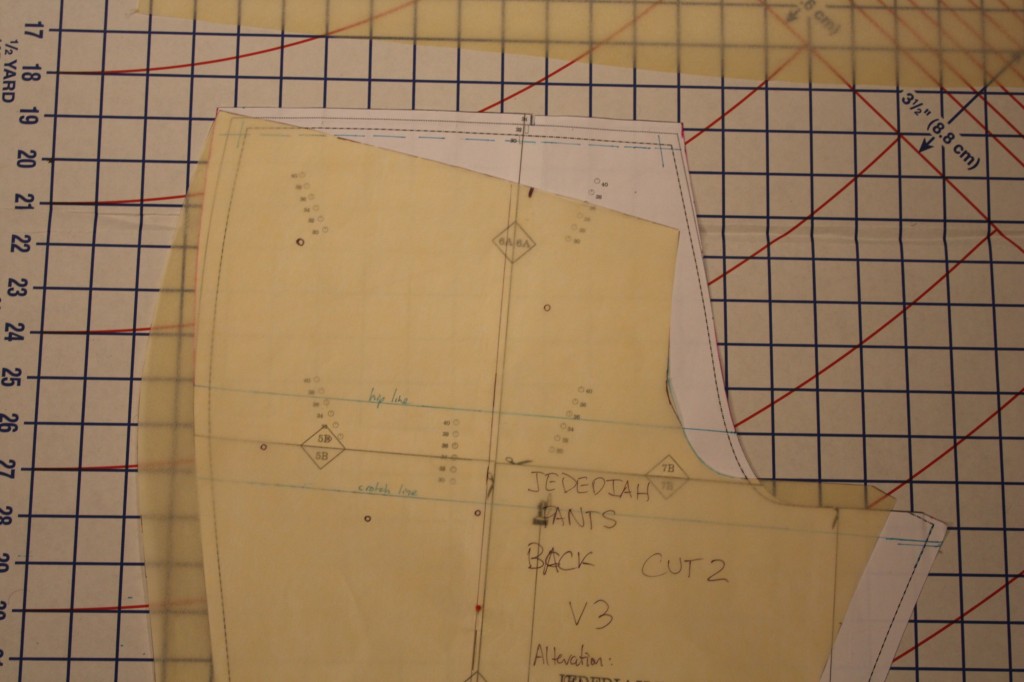
Next, I taped in some additional tracing paper, traced a new outline and smoothed out the crotch seam line. This adds the missing wedge back into the yoke.
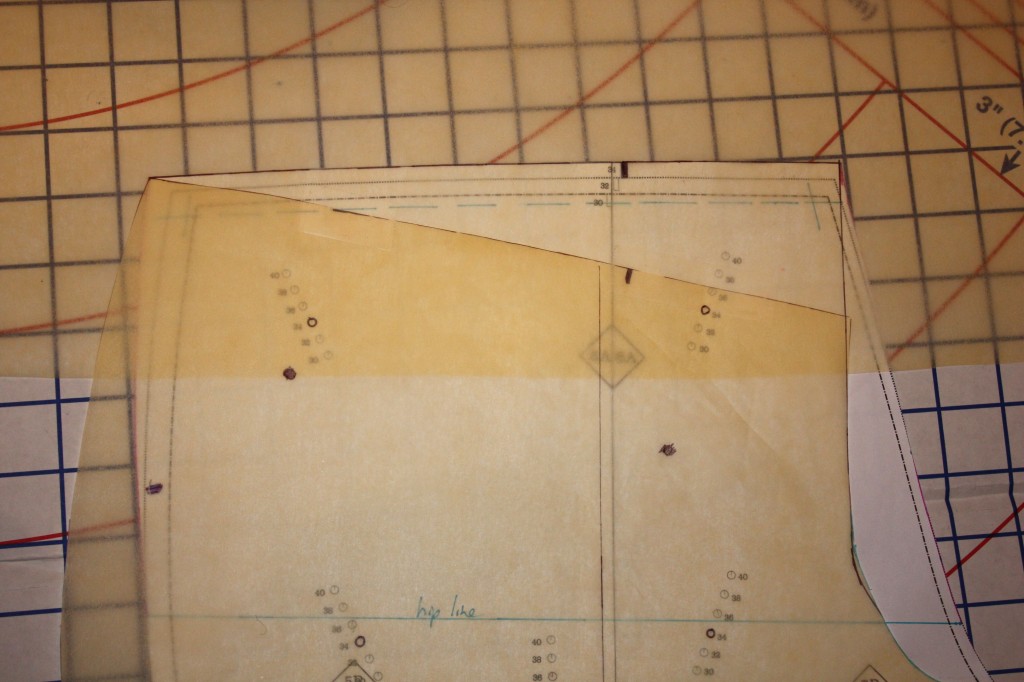 How did this turn out? I have sewn a new muslin with the corrected back piece. The waistband is fixed, but the crazy twist from crotch to knees reamins. I haven’t yet taken photos, but I will share them with you next time.
How did this turn out? I have sewn a new muslin with the corrected back piece. The waistband is fixed, but the crazy twist from crotch to knees reamins. I haven’t yet taken photos, but I will share them with you next time.
The Self-Taught Sewist
As nerve-wracking as this whole process has been, it has been very, very educational for me. I’m learning pants fitting the hard way, by doing it, making mistakes, and learning how to fix them.
Over at the Cutter and Tailor forums, there’s a firmly held opinion that you can’t master a skill as deep and intricate as tailoring via self-tutelage; they liken it to trying to learn how to be a surgeon by reading a book.
To some extent, I think they have a point. But never before in human history has it been so easy for the home sewist to get live demonstration of techniques via the Internet, from Craftsy, YouTube (such as the Peggy Sagers video above), and other resources.
For another example, if you’d like like to learn to properly hold needle, thimble and thread for hand stitching, you need look no further than YouTube to find not one, but two Saville Row-trained tailors to demonstrate:
Sewists of previous eras never had this kind of amazing advantage. I think this ready access to information, live demonstrations, and online discussion broadens the scope of what people can hope to learn via self-teaching.
I do feel like there were spots in this process where I would have liked to have had a human instructor available to ask questions and get advice. Perhaps I could have gotten my advice by asking questions on discussion forums, but I definitely feel I could proceed quicker with an onsite mentor.
But I do feel as if I am learning.
Next Time
Let me know what you think in the comments. I’d love to hear your suggestions for making the crazy twist go away.
Next time, we’ll try to bring pants-fitting to its conclusion.


From what I see on other blogs on the internet, I wouldn’t trust just dart pinching to work for trousers.
You should take a look at the Colette clover fitting cheat sheet: http://www.coletterie.com/tutorials-tips-tricks/the-colette-patterns-pants-fitting-cheatsheet
It’s written for women but it is a good resource nonetheless. They list three possible solutions for your original problem. Looking at the pics, I’d go for flat butt adjustment first, but I’d start with the original pattern.
The cheat sheet looks like it could be very helpful. But 1) I’m not sure how to get the measurements for the slashes and spreads based on what’s presented there, and 2) I don’t have a flat butt!
Going back to the original pattern might make sense, though. Even if my current series of alterations leads nowhere it has still been very educational.
I don’t think you have a flat backside but I’m seeing a slight forward pelvic tilt which can cause fabric pooling under the butt. I have this issue myself. The wedge you took from the CB seam is often the fix for that tilt. A drooped butt adjustment can also help. You can also get under butt pooling if you hyper extend your legs backwards and/or have prominent calves which cause the fabric to not hang freely. HTH, Shari
I also enjoy watching Peggy Sagers shows. We don’t have her show on my local PBS station so I end up ordering a season when it becomes available.
Your fitting issues are very enlightening and helpful.
I wonder if your first attempt at nipping in the dart would have been more successful had you move the tip of the dart to right below the crotch. That would not have changed your crotch curve and kept enough ease for you to sit/bend but removed the extra fabric pooling in that area.
I’m wondering if maybe I should have stuck with the first attempt at nipping the dart, doing just as you suggest. It would have disturbed a lot fewer pattern elements. And Perfect truly is the enemy of Good.
Fitting is difficult. This includes altering RTW, of which I have to do often, so the clothing fits well.
For pants, you should get Palmer/Pletsch book on pants, its a very visual book on getting patterns to fit.
Another helpful way to do it, is deconstruct a pair of trousers that you own and build your own pattern, once you have your “basic sloper done” that will fit you well that it is easy to alter and add design details. For example, adding a yoke for pants just requires removing and closing the dart. Glenda at SureFitDesigns has pant slopers for men that you could even use.
When I use a commercial pant pattern, i take a lot of measurements. I know what i am looking for in the hips, the rise, width at the knee etc. Once you know your details it makes it easier to make the adjustments. I have rarely made a proper muslin, and generally use “stretch denim” with good give for my test fabric, so that I get a fantastic fit. This is why I love sewing with knits, fabrics with lycra, so your fitting does not have to be so precise as with woven fabrics that don’t give. In essence, the stretch in the fabric, allows you to make tighter clothing, and the fabric will give and mold around your body. Good example, jeans with cotton/Lycra that fit like a second skin, are comfortable, and you can move in them.
Good luck with your fitting.
I’ll give the Palmer/Pletsch book on pant fitting a look, if I can find it. I did check out a copy of Fit for Real People from the public library a while ago, and was completely turned off by it. It really should be titled Fit for Real Plus-Sized Women. Great for that audience, but not for me. So I’ve tuned out the Palmer/Pletsch fitting books as a result.
I think I may have to disagree with you on the stretch fabrics. I do love working with stretch fabrics, and right now there’s a sizable amount of knits sitting in my fabric stash. But for a pair of jeans or dress pants, I’m much happier sticking with plain woven fabrics. My first pair of hand-made jeans (documented in detail on this blog) was made with stretch denim. They always feel weird to me and after a year or so of wear, they’re stretching out in odd ways.
Stretch denim, although a revolutionary textile that makes great skin tight jeans for females, is not for men.
Agreed.
In addition, using stretch fabrics won’t teach you how to fit. It is necessary to wrestle with the problems presented by woven material.
Oh, do I remember my early fitting struggles….much like you here, I seemed always to get deeper and deeper into trouble with every new adjustment, while my pattern got weirder and weirder looking and more and more complex, which is rarely a sign that you’re getting close.
Delighted to hear you feel you’re learning from the process. What I learned from mine was that a much easier route to personal fit (i.e., NOT required to understand how to fit ANY body, just to find good solutions for one’s self, so you can get on with the good part: Making!), for me at least, was to try on lots of basic shirts and pants until I found the best fitting ones in difficult to fit areas (shoulders for shirts, rear-end and crotch for pants), then copy these and tweak as needed to get them perfect in the easier areas (i.e., those that simply require length or girth adjustment). Then use the copies as basic blocks onto which any details from all future patterns get swiped and added, without having to also deal with adjusting the garment from the new pattern.
It’s my experience that RTW often fits better than unaltered patterns, especially for those who don’t have profound fitting challenges…which makes sense to me, as RTW HAS to get fit right for the average body, or at least close, since fitting after making is not going to happen, while patterns assume that fitting will happen, or should, before making. So RTW puts in an extra effort/experiment/research on fitting typical humans that sewing-pattern makers (and especially proportional drafts like you’ll find at cutterandtailor) don’t need.
I, for instance, eventually got a better basic pant pattern from a borrowed pair of Dockers than from any of three custom fittings from tailors and full-time fitting experts, all of whom got reasonably close after lots of tinkering…but the dockers just nailed it, in a simple way…with crummy details, but those I didn’t need and wasn’t stuck with.
cutterandtailor is a great and wonderful resource…but it’s also filled with folks staunchly defending the traditions of their own turf and rarely open to alternative solutions, especially from such lowly realms as home-sewing. It’s littered with threads started by hobbyists who wind up getting told that you “can’t there from here”! Which is probably true:)
As usual, I really enjoyed your detailed and thoughtful post! Thanks.
um, “can’t GET there from here”; sorry!
David,
Thank you for sharing your experience. I know from your discussion in Making Trousers that you were not a fan of the fitting process, but your comments here are most enlightening.
I do feel like I’m heading further down a rabbit hole with the process. You always have the feeling that the next tweak will be the last, until the next complication reveals itself. Right now, I am deciding between taking the next tweak, or hitting the reset button and starting over.
One takeaway I’m getting from my fitting exercises is that, for me at least, I need to have a conceptual understanding of the process and I need to reason through the spatial issues involved by myself, even if the ultimate resolution is to perform a cookbook action. The problem you and I both seem to have with the “see this, do that” approaches is that the problem you have never seems to match the list of problem cases the author anticipated.
One reason why I like King’s fitting approach is that his is conceptual, and it’s based around simple concepts: net fabric loss, net fabric gain, no net change. Sadly, Threads magazine never extended his series of articles to cover pant fitting, and Taunton’s price of $149 for two hours of King on video is not a good value.
I’ve seen your YouTube videos on copying a pants pattern. I had wanted to make the Jedediah pants pattern work, partly because I wanted to support an independent menswear pattern maker. But perhaps I should give the idea of cloning an existing garment some serious consideration. I have a few pairs of Docker Alpha pants that fit me pretty well.
Thanks for the feedback.
Wow, great advice Mr. Coffin, especially about how the major companies can nail a good fit for the average Joe, since they have the money, time, and talent to develop patterns and numerous samples. My advice also is to copy an existing pair of pants that fit Corey really well. I do free lance pattern making, and I tell my clients that want to do a jeans or pants line, that they need to give me a pair of what they think are the perfect fitting pants on the retail market. Then I knock off that pattern (keeping the original pants intact for later comparison) and sample and grade from there. This “stealing” of RTW patterns saves an immense amount of time and money, since Levi’s or Dockers or Donna Karan has already done the research and development.
Self taught sewer here who does lots of women’s pants, which definitely have different issues.
What I see is that your pinned in dart starts below the crotch point and angles up to the side seam. Your change to the muslin takes out width above the crotch seam, distorting the posterior of the pants, but leaves the side seam the same. The upper adjustment looks okay I think.
If you move your lower “dart” to start just below the crotch seam where you pinned it, and have it run to the side seam, either at an angle or even straight across, it make make a difference in the fit and what you’re looking for. It may be that it needs to just be a fold even width, and not a dart. Your pinned and marked dart looks in the photo to be almost equal in width across the pant. That way your side seam would be equivalent, and you shouldn’t have the pulling to the sides from the crotch, distorting the crotch to knee on the back. If necessary, you can slash the pants between knee and crotch to get it to hang straight and see where that leaves you.
After all that is said, David Coffin is my hero, having used both his trousers and his shirt books. So maybe for men’s pants, the best way to go is use a pair of Dockers. Not sure about that.
Good luck!
(blush) Thanks Lynda:)
It’d certainly be interesting to compare the way your Dockers fit to other patterns, and it’s very quick to copy them…just two pieces, really. I hope you try that and share your results!
Having some working “blocks” has never stopped me from buying other shirt or pants patterns, but all I usually want from them are the details and sometimes the construction steps; cheap at the price if I learn something cool. Once you’ve got a block, it’s also easy enough to add basic silhouette changes to it, like pleats or leg width, or waist level, without starting over. I’m also a big fan of Corey’s approach of measuring to compare any new body pattern to the measurements I already know will work for me.
I haven’t seen Kenneth’s fitting material, but I’d certainly trust him to be detailed and useful; I’d go for his Trouser Draft ebook if I really wanted to start from scratch, esp. since I assume he’d be open to questions (http://www.kennethdking.com/book/#trouser). Don McCunn’s book on making patterns is my go-to suggestion for getting well grounded in simple fitting logic (http://goo.gl/8yRlzV). I seem to recall getting the idea from there that getting a skirt to fit was a great way to begin with pants, I.e., separating the around the body aspect from the between the legs aspect… excellent for smoothly draping trousers anyway, if not for that butt-hugging thing Levis taught us to love! (Dockers=Levi’s, right?)
But mostly I prefer to skip the fitting and focus on the fun parts of sewing…so a quick copy works for me:) Why not let a huge successful company like Dockers “give” me the results of all their research?
I think with most garment construction projects I do, from shirts, jacket, pants etc, I find that once you have a great pattern as a starting point, you can reflect any design changes that will work for you. This goes back to the concept of a sloper. You should also pick up “metric pattern cutting for menswear” , it is a good resource for where you are venturing.
I find there are certain blocks for shirts that I always use, same for jeans. In a previous blog, I am now working on perfecting selfedged jeans for myself. Kenneth King on craftsy has a course that allows you to “reverse engineer” a garment, which I still think might not be a bad idea for you.
For your current fitting issues, when you purchase a pattern, again it is important that you know your measurements for the kind of fit you want and compare to the pattern. For pants and your jedi pants the hip measurement is the most important and then you need to determine how much ease is built into the pattern. For your pants you also need to determine if the rise is appropriate for you by looking at a pair of pants you like and measuring from the crotch seam to the waist band and compare to the pattern. On most patterns, they project areas where you raise lower lengthen etc.
Looking briefly at your fitting issues, you would most likely have to stitch the crotch/seat seam with a bigger seam allowance and take fabric in on the hips (side seam) to help remove the excess fabric.
When I am starting with a “fresh commercial pattern” that I have never used, I start with comparing my measurement to that on the pattern. I determine where I might have fitting issues, and I do most of the work on paper before I even get to cutting and sewing. I find with my detailed work on measuring and fitting and basically redrafting the pattern, that in 99% of the time i get a perfect fit. The only time it does not work if I screwed up on my measurements.
Again good luck … learning by doing, and making mistakes will increase your skill and knowledge.
“When I am starting with a “fresh commercial pattern” that I have never used, I … do most of the work on paper before I even get to cutting and sewing.”
That’s what I have to do , although I still do a muslin. Previously, I recommended as tracing paper Swedish Tracing Paper or Bosal Create-A-Pattern (the wax paper is for the muslin). Until I started sewing, I had no idea how much the pattern had to be manipulated just on paper before I could sew it up in muslin. I always have to use more than one size and I somehow thought that I could magically connect the pieces of muslin at the machine. :-)
mportuesisf:
Another suggestion is to pick a pattern you love and hire someone to fit it on you. You’ll learn a lot and in a reasonable amount of time have a workable pattern. It’s good that you’re learning by trial-and-error, and you clearly are motivated and hardworking, but it’s easy to spin in circles, take it from one who knows. :-) :-( I know that sewing is expensive. I am recommending this only because it’s worth the money.
And guess what, sometimes the problem IS the pattern, not you. An experienced person will be able to tell you, while fixing the problem.
Thanks for the post. I don’t think any machine has a dedicated basting stitch: you pick the longest stitch appropriate for the material. In women’s wear, you can sew a little running stitch with tail ends that helps you steam and pull up the excess fabric, but I have no idea if that’s a valid technique for men’s trousers. You’ll only be able to use it if you’re sewing wool, anyway.
My two cents: You should sew your first several pairs of trousers in a forgiving wool, like flannel or tweed. Heavy cotton is not easy to work with and tends to show needle marks. I don’t that your current pattern could be sewn in wool.
I don’t know enough about fitting pants to say anything useful. I personally would go over to C and T.
As for the fitting darts, I remember looking at book, seeing a photo with a horizontal tuck in a jacket and wondering why anyone would sew something like that. Only later did I realize that the point was to change the shape, which would be retraced into a new pattern.
Should have been:
I don’t know that your current pattern could be sewn in wool.
I agree, maybe its the pattern, this pattern requires too much alternation for you. I think the pattern needs to be redrafted for you. It is not working big time. Its what I call: a hot mess.
Your best bet, take apart a pair of dockers pants, make your pattern and your done. (make sure you press and starch it, trace it out and leave yourself ample seam allowance. Remember rtw only has 1/4 inch seam allowances since everything is very precise, exact. and I TOTALLY AGREE WITH DAVID, THEY DID ALL THE WORK FOR YOU. They have people who do this professionally for a living. If you want the jedi pocket details .. then just use those pattern pieces.
Basting stitch, old singers from the 60’s use to do a chain stitch. You can pull out a chain stitch pretty easy, if you have a 5 thread serger you could set it up to do it. Or do it with the sewing machine, loosen your tension to almost nothing, lengthen your stitch and sew the seam … it pulls out easy and is the same technique you use to do ease stitching for sleeve caps.
Corey,
I don’t have any problems with the 5mm straight stitch as a basting stitch. I know some other modern machines have an extra-long basting stitch, but it’s probably not appropriate for purposes of sewing a muslin.
Now that I think about it, I have a Brother coverstitch machine that is capable of a chain stitch. I’d still prefer using the conventional sewing machine for the muslin.
I have a top of the line kenmore from 1974 in a desk, great machine, the only thing i hate about it is the left of center needle position. It comes with a chain stitch plate and I can do basting on it. The stitch pulls really quickly.
The other technique that folks use for basting is a quilting foot, drop the feed dogs and you can then control the stitch length and make very long basting stitches.
Doing a ruboff of a pair of trousers is another option, but it’s not always as easy as it looks. I haven’t done trousers, but I’ve copied other garments. “Making Patterns from Finished Clothes” by Tracy Doyle is a good book. I can’t remember if she specifically addresses pants, but the general principles will apply. Ignore the style of the clothes, which are dated.
http://www.amazon.com/Patterns-From-Finished-Clothes-Re-Creating/dp/0806948752
David Coffin has produced some YouTube videos on how to do a ruboff of a pair of trousers. I also have the Craftsy class “Jeanius!” in which Kenneth D. King shows how to do the same thing. If I go down that route, I’ll probably use them both as guidance.
I looked at DPC’s video on copying a shirt and thought that looked very doable. Then I tried doing it myself and, seven muslins later, I’m still not happy. Admittedly, the shirt I was copying was more complex. It had darts and long tucks.
Well, it sounds like you’re covered. For the benefit of other readers, the Doyle book is good.
Sorry you were disappointed! I’ve only ever used my pin method on shirts with garment sections that can all be completely pinned down flat all around, folding out any back pleats evenly all the way to the hem. I seem to have gotten away with measuring and adding on at the upper edges to deal with back darts on most trousers, too. Beyond that, one would probably need something more elaborate, such as Kenneth describes.
I think my issues had to do mainly with my choice of shirt and limited pattern making experience. My comment wasn’t a criticism of you, rather an observation that many techniques are harder than they look, at least if one wants a professional-looking result.
One of the biggest problems with the Jebediah Pants pattern from what I have seen from your’s and other blogs is the lower portion of the back rise. I would describe that shape as almost a right angle, creating an unflattering a seam that goes right into the butt crack. If you inspect other patterns, you will see that curve shape is shallower and the crotch point is set further out and somewhat lower. Those changes alone to your back rise will go a long way to improving the fit.
You may be better off “knocking off” another pair of pants that fit you perfectly, rather than trying to customize what I think is a poorly drafted commercial pattern. There are ways of “stealing” a pattern from an existing pair of pants without destroying them, or you can simply cut apart the pants if you have no emotional attachment to them. Taking apart apparel has been one of the ways I have learned construction, and created better fitting patterns.
I have to agree, Thread Theory has inferior patterns that are ill fitting and poorly designed.
Unless as a man your a size 12 girl/woman .. you will not fit them even if they are designed for men.
The cost is high, the design is poor.
Just deconstruct your trousers and make your own pattern, you will soon find that you can use it over and over again, ..either until you gain more weight
Now that is the biggest issues for sewing: weight, bodyfat .. big muscles changing sizes .. a nitemare for fitting
I think I feel a blog post coming.
John,
I did catch your comments about the Jed pattern from one of the earlier posts on my blog. I agree with you that the curve of the crotch seam is too square; it cuts too far in to the, for lack of a better term, “butt crack”.
I guess at the time I was more concerned with making the puddles of fabric under the seat go away, and would deal with the crotch curve separately. But now I realize the two issues are related.
Aloha Michael,
Great effort into the un(know) best pattern fitting for your body(booty). I too have had similar issues as shown on your muslins. A while back I demolish a pair of my favorite RTW pants for a best fit pattern. It worked. I also did a correction, in another pants: increase the crotch so the fit was adequate for my body. Decrease on the L and R pant leg starting at the waist(aka dart if you will). For me, a short waist and (larger economical size booty) is a real problem. This is how I learned to fit most patterns. Granted I always cut my patterns a bit bigger size(you can fix a larger size) even after I take my measurements, study the pattern pieces, make a muslin. I also sign up for a fit pants class at craftsy.
Thanks for sharing
All the best
Mele Kalikimaka and ahui hou
Josie,
Good to hear about your success copying a RTW pattern and then tweaking it.
The only dedicated pants fitting class I know of at Craftsy is by Sandra Betzina. I signed up for her Pants Construction class and thought it was terrible, one of the few Craftsy classes I thought was a waste of money. Sandra Betzina is now on my blacklist for all sewing instructional purchases. If that’s what you signed up for, I’d be very curious if you could share your thoughts on it.
<>
I wouldn’t be too hasty to dismiss her from that one experience. She does have a unique persona, but her Power Sewing and fabric books are totally worth reading/owning, esp. now when they are no doubt lots of used copies to be had for next to nothing.
David,
I’ll be on the lookout for those books if I can find them used. I have no doubts about Betzina’s credentials; I just find her live teaching style difficult to follow.
Josie, My review on Sandra Betzina’s Pants Construction class: http://sewing.patternreview.com/review/review/3143
You are doing great with the pattern. Although it may not have been the greatest base pattern you are doing great. It may take 10 muslims to get it though and it is hard to be patient.
What you seem to have now is the top part OK and then the twist and angles in the leg. Where the twist begins, either slash or unpin the entire seam up to that point, letting the fabric fall where it wants to and then repin as it falls smoothly to get an idea of how it changes. I have a feeling that you may need to add back the length you took from the outer side seam above the crotch, back to the leg below the crotch.
Part of the problem is addressing the curved dart you initially pinned out. A solution may have been to convert this into 2 straight darts for the pattern changes, one approx horizontal and one diagonal dart to more faithfully replicate the curve. Peggy is great, but a lot of things she makes look easy peasy and then one gets stuck when the changes are more complicated. My other annoyance with her is that she always talks about single pattern piece changes in isolation, and rarely addresses how the altered pieces fit together with the other pattern pieces if you have made a seamline length alteration, you will have to address how to change the seamline of the pattern piece to which it must be sewn.
For what it’s worth, I am not such a fan of copying garments as RTW often uses shortcuts like stretch fabric to counter fitting issues and these garments are hard to copy accurately as many of the seams are slightly eased in sewing, almost impossible to determine in a rub-off.
I agree you about Peggy Sagers on all accounts. She is great, but she does make things look too easy and all the details (such as truing matching pieces) you’re on your own.
I would be inclined to continue heading down the road of tweaking this muslin to fit, EXCEPT I don’t have any good way to resolve the twist lines that have developed in the legs. I could back up and start again with the original curved dart I pinned out, but at that point I could just as well start from another pattern.
Stretch fabric does seem like it’s an issue for women’s wear. But for a pair of men’s jeans or dress pants, I can’t recall ever having seen a RTW garment made with stretch fabric.
Ooops, I missed the part where you gave me specific advice for resolving the twist. I’m considering it carefully.
One thing I may not have been clear about in my original article; I abandoned my first curved dart. I went for a dart in the other direction, with the apex on the side seam so the length of the side seams has not been altered. The lower crotch seam however, has been shortened considerably.
That said, I’m now understanding where that twist is coming from. More on this next article.
BTW, I totally agree with you re the amount of resources available to us home sewers now. No need to be overcharged for less than stellar material that may or may not be relevant! Part of the issue is just thinking and experimenting. It is really hard for adults to do that, we want success right away!
I have to disagree with you. To seek help from an experienced professional does not mean one needs instant gratification. Even with an expert, it still can take considerable time to perfect a muslin; the benefit is in reaching that stage faster, with less frustration, while receiving informed explanations and can be applied to future projects.
A sewer is never disadvantaged by working with a congenial person who knows her or his stuff. Sadly, there are many people who post tutorials who simply aren’t qualified. Then in the comments you see inexperienced sewers falling over each other to praise mediocre, or even awful work. It’s pathetic. And some of these people do charge a lot for their services, which is criminal.
If one hasn’t the money, that’s one thing, and a real thing, but this attitude of disdain displayed by many home sewers towards professionals is baffling to me. When the assistance comes from a knowledgeable, skilled person, it ‘s completely worth the money.
By the same token, I’m not a big believer in paying someone to teach me basic skills that I can learn from books or the Internet. When I first started sewing three years ago, I learned basic machine operation and how to read a pattern by watching videos on YouTube. Most basic sewing skills I learned from watching Nancy Zieman on TV, and reading books.
Given the higher cost involved for personal instruction, I’d really like for it to be about something that is challenging and difficult to master on my own.
It’s not the same coin.
First, yes, people can learn basic construction skills from free videos, but they often pick up bad habits that they have to relearn later if they get serious. Just as often they don’t learn what is good work, which is why you see beginning sewers posting things that have lots of problems being praised by other beginning sewers. You see blatant misinformation being posted.
Second, fitting is a notoriously difficult skill and you seem to be struggling.
I think there’s something to be said about the source of the information. I hope that with 30+ years of sewing instruction under her belt, Nancy Zieman wasn’t doing me too wrong by demonstrating the correct way to ease in a seam, or to put in a zipper on television. On the other hand, YouTube videos are of wildly uneven quality and I tend to view them with a grain of salt.
This is my first serious fitting project with pants. I would be surprised if I weren’t struggling with it.
mportuesisf:
Pants are hard. I’ve seen people with construction experience work to fit themselves and I see the efforts of the men on Cutter and Tailor, most of whom sew very well. I wouldn’t dream of attempting to fit pants on myself right now, especially without some kind of form.
As for sewing instruction materials online, certainly someone with a track record is better than a newbie, but you weren’t impressed by Sandra Betzina, who I assume has 30 years of experience and whom many people seem to like. (I don’t know her products.) I said in a previous comment that the experience with a teacher is partly subjective. But one-on-one definitely adds a dimension. Instead of generic advice, the advice is specific.
I wouldn’t have suggested getting help if I didn’t think it was the best and most efficient method for you.
Stoting Stitch:
I’m sorry for making it seem as if I’m indifferent to your criticism and your suggestions for the best path forward. I do hear your message. Having someone who can answer questions and evaluate my work would greatly help me more forward.
I’ve done a bit of searching for instruction local to the Bay Area online, and I’ve also looked at the bulletin board at a local fabric store that does quite a lot of business for fashion students. The sewing studios I’ve found that offer instruction offer mainly beginner’s classes, or cater to quilters/crafters. There are a few people who offer studio time with one-on-one instruction, but I have no way to know what their credentials or their teaching abilities are. The only way to know is to try – which is a risk.
Locally, there is a school called Apparel Arts (http://www.apparel-arts.com/) that offers courses intended for industry professionals. They accept amateurs, and I have seriously considered taking courses there – the only obstacle being fitting them in (no pun intended) with my work schedule. The thing is, they offer courses in pattern drafting but not fitting, no doubt due to their industry orientation.
Long story short, finding appropriate instruction could be as much work as toughing it out on my own. And there certainly isn’t something I could sign up for tomorrow. I haven’t tried approaching local tailors but I can’t imagine any of them wanting to take time to help me, regardless of the fee involved.
As for Sandra Betzina – She’s no doubt knowledgeable, but her style just didn’t work for me. Others love her. I have two of her books on order, one of them on fitting, because I want to re-evaluate and reconsider.
mportuesisf:
Thanks. I get it. It took me a really long time to find a teacher. Although she’s reasonably priced given her background, I still can’t work with her as often as I’d like. I’ve taken a lot of courses and learned good construction methods, but the classes also were industry-oriented so I wasn’t able to get extensive fitting help. One of the few times I’ve seen fitting done on a real people there is in the full-time Menswear program. The first-term students draft patterns based on their measurements and then a professor fits their muslins three times, after which they make them up. For a time, I looked for a fitting buddy through the web, but came up dry.
I wasn’t making any judgment about Sandra Betzina; as I said, apart from her name, I know nothing about her. I have, however, used some materials from the very popular “Fit for Real People” series and sometimes find the methods too home-sewery. For example, instead of making a muslin, they recommend pin-fitting the pattern itself. With Big 4 patterns, the tissue rips. My method, which is to trace on to Swedish Tracing Paper and then to make a muslin is actually more efficient and precise, not to mention economical, because the pattern is preserved. Admittedly, they said that most of their clients weren’t interested in doing muslins. Maybe that’s changed. But a lot of shortcuts for home sewers actually make the process take longer.
I’ve read that one of the best books on fitting is Fitting and Pattern Alteration: A Multi-Method Approach, by Elizabeth Liechty, et al. I looked at it in a library and found it very comprehensive, but don’t recall if it covered fitting for men.
http://www.amazon.com/Fitting-Pattern-Alteration-Multi-Method-Approach/dp/0870057758
For construction and pattern making videos (although I don’t think there’s anything on tailoring), I like the University of Fashion, a subscription service set up by some fashion design teachers, all of whom have had some professional experience. They are very clear, and transcripts are provided.
Happy New Year!
I had to add one more comment on this thread. Carefully inspect your photos and you will see that all drag lines on your I’ll fitting muslins radiate from your crotch point out to the side seams. The problem is that that pesky crotch point to too high, pointing upward as it enters the crotch, consequently pulling your fabric into the crotch, and causing all those unsightly drag lines. My opinion is that no amount of taking in darts at those lines will cure the fitting problems. Instead you need to add to the crotch curve, how much depends on how large the drag line is at the crotch. So, to proceed you either redraft the crotch area, or as I have previously suggested, knock off another pair of well fitting pants.
OK, one more note…
In my experience trying to get pants to fit correctly around the buttocks and crotch the solution is always reshaping the crotch curves in the front and back, or as tailors say, the back and front rise. Once you have the waist and side seams fitted, then it’s time to fix the rise. If you have fullness in the back crotch, pin out the fullness, making a two ended dart. Using this dart, take away approximately that same amount in the rise. If you have smile lines in the front, deepen the front rise curve. Notice most changes are made to the crotch curvature, not sewing darts. Try this on your next pair of pants.
Worth considering; on sale now:
http://sewing.patternreview.com/cgi-bin/sewingclasses/class.pl?id=153
I was always impressed by Sarah when we worked on articles together at Threads.
David,
Thanks for the recommendation, I’m carefully considering it. I’ve spent a lot on sewing purchases this past month; I wonder how long the class will be on sale.
Though I’ve purchased several Craftsy lessons, I’ve never tried out a Pattern Review class so I’m not sure what the features are. I know there’s a class chat, I’m wondering if I can upload pictures if I’m seeking assistance.
Also following your suggestions, I’ve ordered used copies of Sandra Betzina’s “Power Sewing” and “Fast Fit” from Alibris. I notice Kenneth D. King recommends Betzinas “Fast Fit” as a resource in his trouser draft ebook. I’ll see for myself soon enough.
Good to know. I was all set to take a Pattern Review class on underlining with Sarah Veblen, but on top of the class fee she insisted that students buy an expensive kit with fabrics and as I had all of them on hand., it wouldn’t have been a good use of money. That’s not an issue for this class. It’s BYOM — Bring Your Own Muslin.